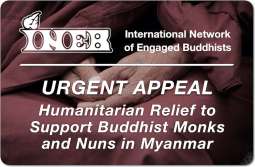FEATURES|COLUMNS|Ancient Dances
Dance as Knowledge, Part Three: Building a Research Team

Vajrapani, performed by Shri Prajwal Vajracharya, 35th generation Newar
tantric Buddhist priest and dancer, part of the Mudra & the Diamond Sphere
project research team. He will dance, syllable by syllable, an 11th century text
on 21 October. On the same day is a new film by Yangchenma Arts & Music of
a rarely seen Mahakala deity dance by Prajwal. See details below.
Image courtesy of Core of Culture
There are some good books about Buddhism and dance. Czech linguist René de Nebevsky-Wojkowitz’ posthumous Tibetan Religious Dances (1976) is a fine grounding in the schools and basic role of cham dance. Its centerpiece is a translation of the Fifth Dalai Lama’s Chams Yig, or dance manual for a large cham ceremony at the Potala Palace. Nebesky-Wojkowitz perpetuated the myth that there was only one chams yig and that it was a big Gelug text. In fact, there are many chams yig of different types, usually the product of individual monasteries, some more visual, some a combination of symbols and text, some merely shorthand and lists of names and deities; and some written in both contemporary and archaic styles of the Tibetan language. Movement traditions and writing traditions come together.
The question moves from “where’s the text?” to “how do they remember the dances?” Dance is remembered variously, primarily in bodies. Nebesky-Wojkowitz believed that the existence of such “choreographical manuals” was the reason for unchanging traditions over generations and the uniformity of dances among monasteries. That might be what a European linguist would think: things center on a dominant text. It’s a prevalent idea. Where there are longstanding movement traditions, the transmission of movement itself is the key to survival. The situation today, which includes any number of monks and monasteries existing in exile from Tibet, is such that there are many examples of dance traditions without a chams yig. The dance escapes in the bodies, the book doesn’t always make it.
 Dr. Thinles Dorje of Shara, Ladakh, was a Drikung Kagyu monk since he was a boy. He left monastic life and earned a PhD in Buddhist ritual from Punjab University. He is knowledgeable in both Buddhist monastic and Western scholarly systems, and knows how to perform monastic dance and ritual. Thinles will present monks dancing and demonstrating rare ritual mudra on 21 October. See below for details. Image courtesy of Core of Culture
Dr. Thinles Dorje of Shara, Ladakh, was a Drikung Kagyu monk since he was a boy. He left monastic life and earned a PhD in Buddhist ritual from Punjab University. He is knowledgeable in both Buddhist monastic and Western scholarly systems, and knows how to perform monastic dance and ritual. Thinles will present monks dancing and demonstrating rare ritual mudra on 21 October. See below for details. Image courtesy of Core of CultureBuddhist and dance studies owe a lot to Nebesky-Wojkowitz. Dance was not his subject. He noticed, where others did not, that dance was central to Buddhism and to Tibetan society, and quite unlike dance in the West. So he did what a professional linguist would do: he sought out the most important text on dance and translated it. His theory about the role of the dance manuals, his attempts at photography, show how genuinely interested he was. Giuseppe Tucci was another earlier explorer and ethnographer who appreciated the elemental role of dance in Tibetan culture.

Shawa cham stag dance, winter ceremony, Matho Monastery, Ladakh, 2014.
Photo by Nathan Whitmont. Nathan is part of the Mudra & the Diamond
Spheres research and documentation team. A short dance film he
co-produced, Ocean of Mudra, will be shown 21 October. A live Shawa
cham demonstration will be also be performed. See below for details
The relationship between dance and written text is rarely direct. One reason dance exists is because it allows expression beyond the limitations of the written and spoken word. Dance exists in mystical traditions, in part because it is a pre-language form of communication as well as a supra-linguistic form of knowledge and expression. Mudra accompanied the spread of tantric Buddhism across Asia to Japan and Java. Better to “read” the dance; to explore the movement of mudra itself. It is remarkable that, inspired by the English photographer Eadweard Muybridge, Nebesky-Wojkowitz attempted a sequential form of photography to illustrate the dance, as it were, step by step, click by click. He used a single danced turn to demonstrate this. These photo sets are included in his book.
Ellen Pearlman’s more recent, well-researched, and lavishly illustrated Tibetan Sacred Dance: A Journey into the Religious and Folk Traditions (2002) comes with a recommendation from His Holiness Dalai Lama, who points out that dance, among all of the aspects of Buddhist heritage, has received “comparatively less attention.” It is for this fact—that dance and movement studies within the study of Buddhism is scant, rarely done by those with knowledge of dance, or involving Buddhist dancers and practitioners—that Core of Culture has assembled a unique research team for its current project, Mudra & the Diamond Spheres, looking at the mudra used in the Vajradhatu ritual at Tabo Monastery in India’s Spiti Valley. The photos, captions, and text here introduce them. It is a new kind of research team centered on supporting monastic communities as they carry on their ancient spiritual practices.

Celebrated classical Indian dancer Sharon Lowen performs Pasyati Dishi
Dishi, from a 12th century poem used for temple dances. Classical Indian
dance today has a robust tradition of scholarship around it, including many
dancer-scholars, who are often also adept in religious practices. Sharon
is part of the research team for Mudra & the Diamond Spheres and will
dance on 21 October. See information below
There is traditional scholarly work in Buddhist dance. A good example is the 1994 essay by Mona Schrempf, “Tibetan Ritual Dances and the Transformation of Space.” Even the University of Oxford has produced a PhD scholar who wrote on Buddhist ritual dance. It is important not to confuse the recipe for the meal, and replace a Tibetan valuation of dance with a Western one. Reading a lot of recipes does not mean knowing the taste of the meal, or indeed how to cook. It means knowing a lot about recipes, and that is important information. But a recipe is not a meal. A dance manual is not a dance. A tantric Buddhist ritual text is not a tantric Buddhist ritual. These are separate streams of transmission, handed down through the ages.
Both the text and ritual act live on, and the ritual has a parallel stream of transmission, person to person, over generations of Buddhist practitioners. This transmission—the essence of practiced Buddhism itself—is harder to get close to and requires the trusted involvement of exponents of traditional Buddhist movement traditions, such as ritual mudra (yogic movement of the hands) carya nritya (Newar tantric deity dance) and cham (monastic yogic dance).
In a quiet but extraordinary life, scholar Miranda Shaw, professor emerita at the University of Richmond, Virginia, spent years in the Kathmandu Valley studying not with our esteemed colleague Prajwal Vajracharya but with his father. She watched Prajwal grow up. It is no longer possible to witness the amount and type of knowledge that Miranda has learned. Those days are gone. She lived in a Nepal that is from another era. She knows how to perform the ancient, long-secret, carya dances, but is known for her books. Her book on carya is forthcoming. It is the combination of practical and scholarly knowledge, dance, and language skills that places Miranda ahead of everyone in terms of knowledge of dance in the Himalaya. Miranda will offer observations on our team’s work in Newar Buddhism on 21 October. See below for more details on this event. On the same day, Professor of Dance and Cultural Engagement Ann R David of the dance research faculty at the University of Roehampton, London, will offer observations on the role of Indian culture in Tibetan studies regarding movement.

Prof. Lindsay Gilmour, University of California at Irvine, performs Arriving.
Lindsay specializes in embodied research and exploring states of being during
transformative dance experiences. A film co-produced by Lindsay, Ocean of
Mudra, will be shown on 21 October. Lindsay is part of the research team for
the Mudra & the Diamond Spheres project and researched in situ with Buddhist
monks and nuns in the Himalayan foothills. Image courtesy of Core of Culture
Karin Altmann is a textile specialist whose study on Bhutanese textiles, Fabric of Life: Textile Arts in Bhutan (2015), surprisingly tells the story of Bhutanese dance very well, especially dances of the 15th century treasure-revealer Pema Lingpa. American dance pioneer Ted Shawn (1891–1972) was the first to film Buddhist cham in 1926, more than 30 years before Nebesky-Wojkowitz tried photography. Like Shawn, Indian art historian and philosopher Ananda Coomaraswamy (1877–1947) made film documentations of ritual dances throughout Asia. These sets of films provide a baseline of pre-modern Asian ritual dance. In the 1930s, Swedish aristocrat and ballet founder Rolf de Mare embarked on his highly productive documentation of Indonesian dances with anthropologist Claire Holt. There are documentations of mudra in Buddhism, but in fact dance has been better documented.
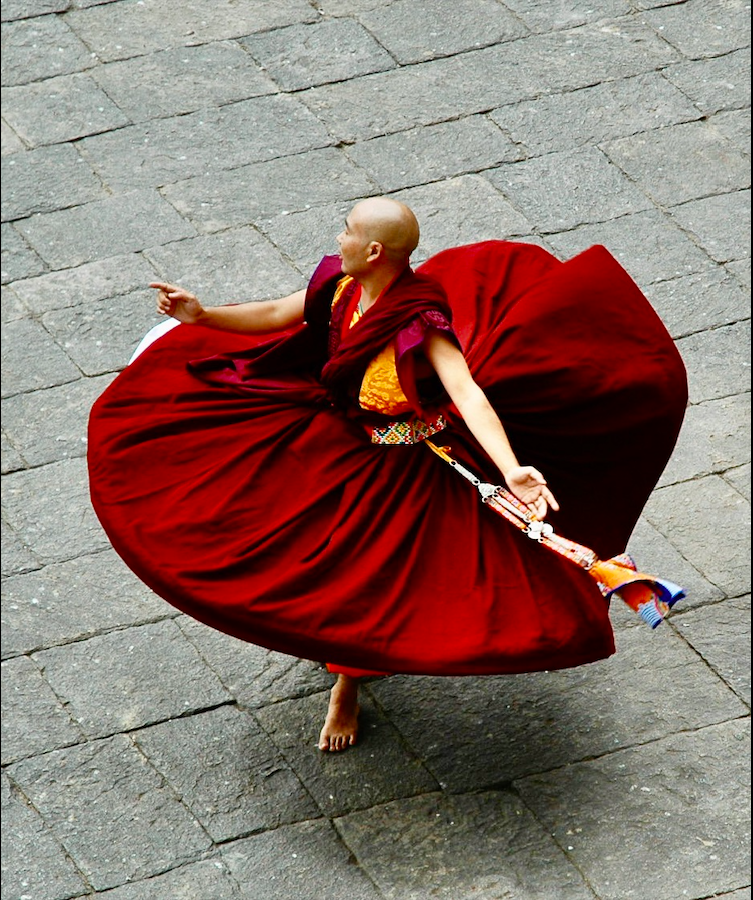
Drukpa Kagyu monk dances in a drubchen ceremony, Thimphu Dzong,
Bhutan, 2005. A graceful example of mudra and dance and state of mind.
Photo by Gerard Houghton for Core of Culture. Core of Culture is conducting
a project now, Mudra & The Diamond Spheres, assisting the continuity of
Buddhist mudra practice at Tabo Monastery with documentation and research
From 2003–08, US-based non-profit Core of Culture produced 500 hours of baseline documentation of sacred dance in the Kingdom of Bhutan, during the final five years of absolute monarchy. It is a baseline documentation of cham in a pristine condition. This is all part of how the West has encountered, studied, and recorded movement traditions in Buddhism over the past century. Dance, in its broadest sense, is a discipline that can include all ritual movement traditions in Buddhism, such as the use of mudra, the esoteric sign language of the ancient world. These movement traditions, handed down since ancient times, are primary source material for movement and dance researchers.
Translation, documentation, and visual research are each part of a Western appreciation for the value of dance in Buddhist cultures, so unlike our own; neither commercial, social, theatrical, nor sexual. Yogic movement is the total bodily etiquette of spiritual discipline. It is dance as spiritual practice; dance as tantric yoga; tantric yoga as physical form in action. It contains and conveys ancient knowledge entrusted anew to each generation. Dance is a repository of knowledge charged with carrying on the forms and techniques of transformed embodiment, experiencing body and mind in an awakened state.
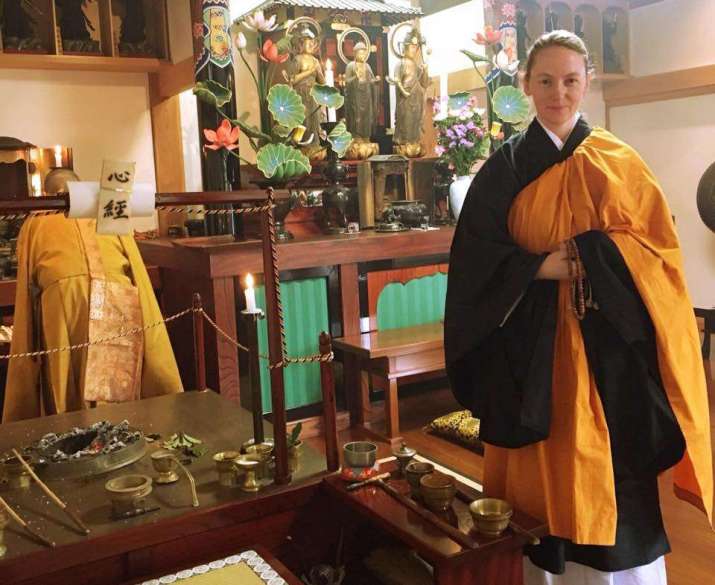 Dr. Elizabeth Tinsley, University of California at Irvine, is ordained and initiated into the Shingon school of esoteric Buddhism on Mt. Koya, Japan. Elizabeth will lead a discussion with dancer Lindsay Gilmour about Buddhist movement traditions on 21 October. See details below
Dr. Elizabeth Tinsley, University of California at Irvine, is ordained and initiated into the Shingon school of esoteric Buddhism on Mt. Koya, Japan. Elizabeth will lead a discussion with dancer Lindsay Gilmour about Buddhist movement traditions on 21 October. See details belowThe Buddha’s enlightenment was an experience. It is the model of everything. Buddhism is fundamentally an experience of approaching personal buddhahood; producing within oneself an experience of enlightenment. Traditional Buddhist societies have old, longstanding ways of doing this: ritual chant and dance; mantras, mandalas, and meditation. Societies without such traditions—such as many Western societies—come to the idea of personal buddhahood using chant and dance and meditation from a more personal and objective place; a new place in Western scholarship and habit, not an old one; certainly not from millennia-old spiritual practices.
Buddhist studies is a comparatively new Western academic discipline; dance research and study even younger. Our project, Mudra & The Diamond Spheres, brings traditional Buddhist movement exponents from Nepal and across the Indian subcontinent, together with Western dancer-scholars and scholar-practitioners.
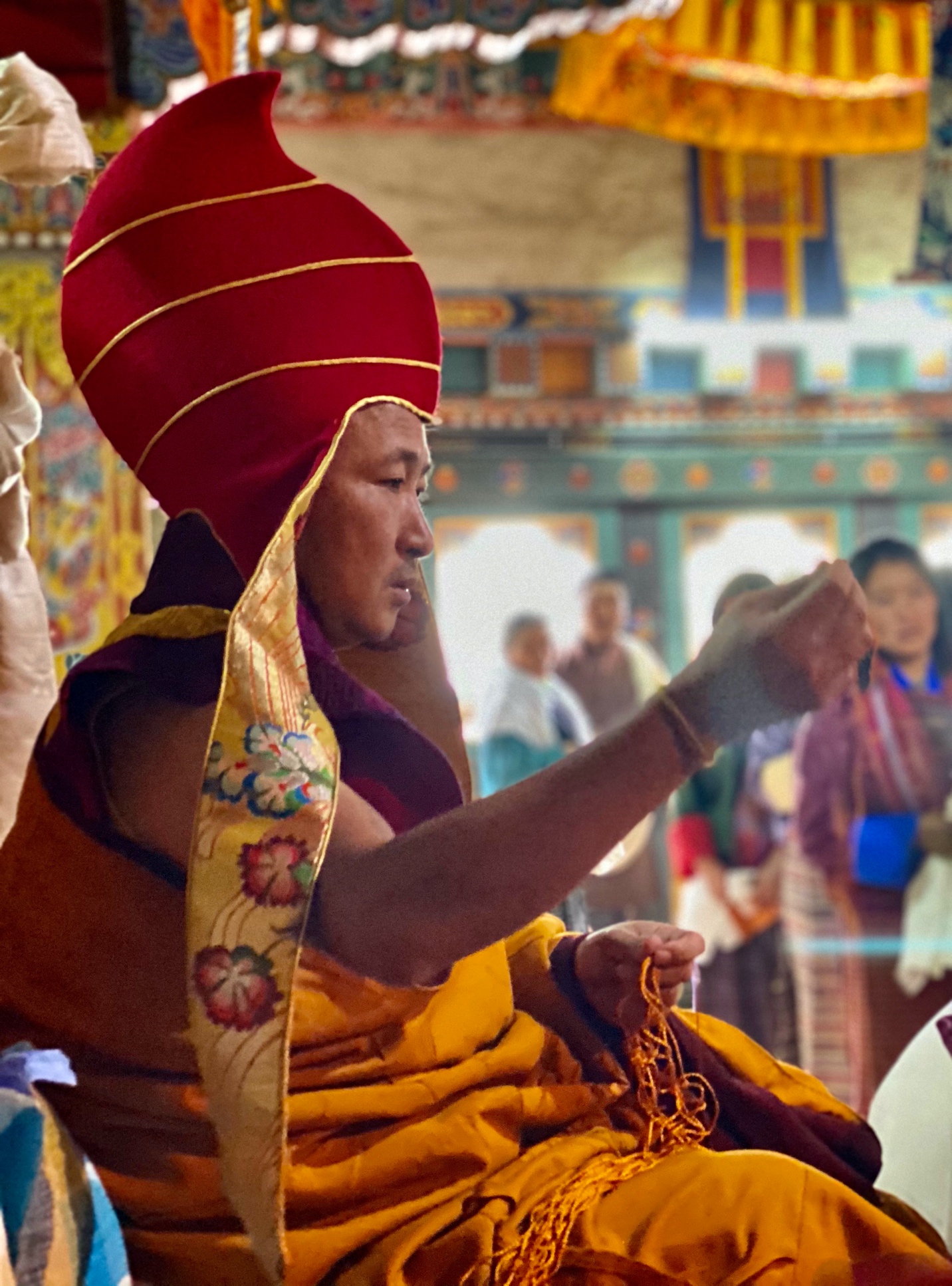
Most Venerable Khenpo Kinley Gyaltsen, abbot of Sumtrhang Samdup
Choedzong monastery, Bumthang, Bhutan. Khenpo Kinley is part of the
research team for the Mudra & The Diamond Spheres project. He brings
authoritative teachings and texts to bear on the work, and develops a Buddhist
monastic response to modern research in movement. The abbot will open with
a blessing on 21 October. See details below. Image courtesy of Core of Culture
This team is composed of different types of Buddhist traditions and types of Buddhist scholarship, including monastic scholarship and Western academic scholarship, in harmonious interaction with authoritative exponents of ancient lineage traditions of Buddhist practice. Newar Buddhist practices, as sustained by the Vajracharya and Sakya lineages of the Kathmandu Valley, are the oldest known extant form of Buddhist practice. With a history spanning nearly 2,000 years, Newar tantric Buddhist priests today maintain esoteric transformative dances that were kept secret for centuries until 1957. Prajwal Vajracharya is a 35th generation Newar tantric priest, one of the finest dancers of his generation and a vital figure on our project research team as we explore mudra in Vajrayana Buddhism. To meet Prajwal is to understand how a dancer is a repository of knowledge. Within his body, a lexicon of dances and rituals and songs and mantra reside. For this group of traditional exponents and scholar-practitioners, Buddhism is a living movement practice with ancient roots.

Dr. Vena Ramphal is a professional classical dancer and a tantric yoga adept.
She also holds a PhD from SOAS at the University of London in Philosophy
and Dance. A film Vena produced, Shaping the Timeless, will be shown on
21 October. See below for details. Image courtesy of Core of Culture
Mudra & the Diamond Spheres Year One Research Celebration with Film, Dance, and Dialogue
21 October 2021, from 9am CST (2 hours)
Hosted by Yangchenma Arts & Music, this presentation of the year’s work is artistic and scholarly, created by scholar-practitioners and traditional exponents. It is a rare assembly of exceptional individuals, gathered to honor Tabo Monastery and its practice of the Vajradhatu ritual, to share and explore knowledge, using mudra as a lens. The program is specialist access and research offered in a popular way to raise awareness of the issue of endangered ancient practices, what we can learn, and how we can help.
For full details: https://www.yangchenma.org/mudra-3-year-one
Mudra & the Diamond Spheres lead funding provided by The Robert H. N. Ho Family Foundation, with additional support from the Kipper Family Foundation.
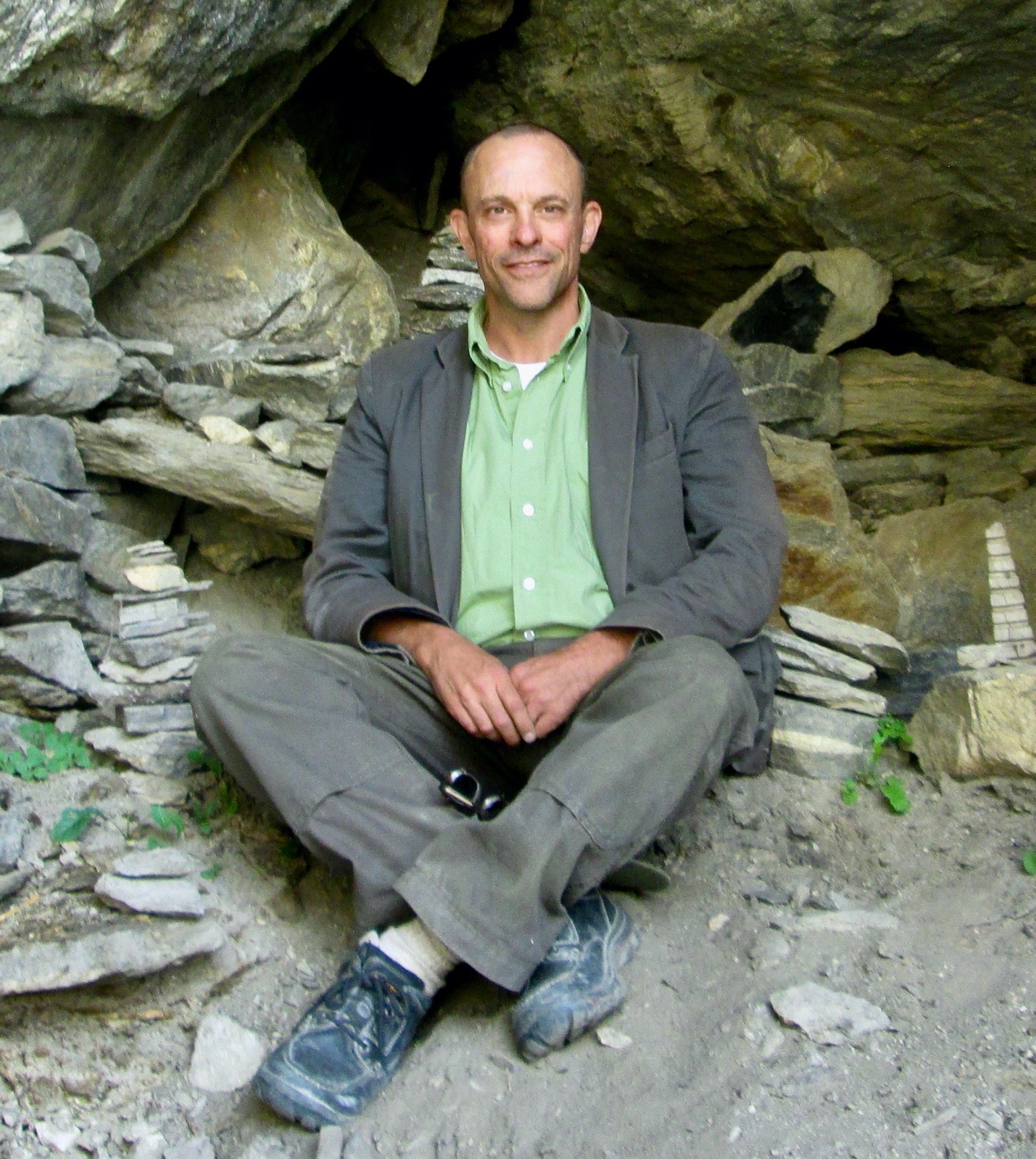
Joseph Houseal below Naropa’s cave, Zanskar, 2017. Joseph is the
founder of Core of Culture and director of the Mudra & The Diamond
Spheres project. He will moderate the program on 21 October
See more
Core of Culture
Mudra & the Diamond Spheres
Related features from Buddhistdoor Global
Dance as Knowledge, Part One
Dance as Knowledge, Part Two: Wu Nuo

